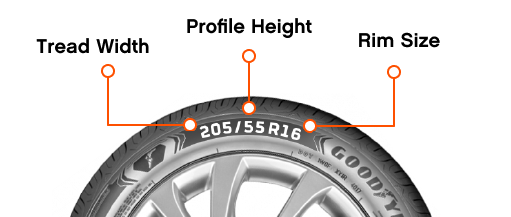Complete 3 steps to buy & book online


The markings on your tyre contain important information about the make and dimensions of your tyre, including its size, how much weight it can carry, and what speed it can tolerate.
It’s important to know how to read these markings, because when it comes time to replace your tyres, you’ll need this information on hand. Fitting the wrong tyres not only impacts how your vehicle performs, but also your safety on the road.
Where to find your tyre’s specifications
The best way to find information about your tyre is to check the markings on the tyre’s sidewall. You can also find your vehicle’s tyre specifications, as well as information about recommended air pressure, in the owner’s manual, tyre placard (usually found in the driver’s side door or in the glove box) or printed on the inside of the driver’s side door.
Tyre markings explained
On the side of your tyre, you’ll find the tyre brand and pattern description, as well as a set of numbers and letters that represent the size, load index and speed rating of your tyres.
Brand & Pattern
Your tyre marking will include the name of the manufacturer, for example, Goodyear, as well as the model of tyre, for example, Eagle F1.
Size, Load Index & Speed Rating
Your marking will include a set of numbers and letters that provide information about its size, as well as the maximum weight and speed it can sustain.
For example:
155/80R12 94Y
155
Width: The number before the slash is the width of your tyre in millimetres. This is measured across the widest point of your tyres. In this case, the tyre has a width of 155mm.
80
Profile: The two-digit number that comes after the slash is your profile, also known as the aspect ratio. This number is a percentage of your tyre’s width and represents the depth of the sidewall (the sidewall is the wall at the side of your tyre). So, the tyre’s profile is 80% of its width, or 124mm.
R
Construction: The letter that follows the profile represents the internal construction of your tyres. This gives you information about how the tyre is made and reinforced. 98% of passenger tyres have radial ply tyres, which is what the R stands for.
12
Rim: Next comes the rim. This is the diameter of the wheel that the tyre is designed to fit on. The rim is measured in inches. This tyre’s rim is 12 inches.
94
Load Index: The load index indicates the maximum weight that your tyre can tolerate. These two-digit numbers correlate to a load index chart[1] that will tell you the maximum weight your vehicle should carry. In this case, the 94 indicates that the tyre can tolerate a maximum weight of 670kg.
Y
Speed Rating: The speed rating indicates the maximum speed that your tyre can safely tolerate. The speed rating[2] is represented by a letter, with each letter representing a different maximum speed. In this case, the S indicates the tyre can tolerate a maximum speed of 180km per hour, although it’s always necessary to observe local speed limits.
Do all tyres have the same markings?
Some cars are equipped with tyres that are specifically made for them. These tyres will have an OE marking on them, which stands for Original Equipment. It’s recommended that the tyres on these cars are only replaced with the appropriate OE tyres. Some cars, such as Mercedes and BMWs use RunFlat tyres. These tyres will be marked with an RFT. Commercial and light trucks also use specific tyres and these are marked with a C or an LT.
Replacing your tyres?
The average tyre lasts for about 40,000km, so depending on how much you drive, and how you treat your tyres, you can expect to replace them every two to three years. There are hundreds of tyre options to choose from so knowing how to read your tyre size will save you a lot of time and hassle when you need to purchase new ones.
If you’re in the market for new tyres, you can use the markings to find the right fit for your vehicle. All you need is the width, profile and rim diameter. Make sure to check each tyre as you may have different sized tyres on the front and back of your vehicle.
Need help?
Our team of tyre experts is ready to assist you in finding the perfect tyres for your vehicle. Give us a call today at 13 23 81 to receive personalised guidance and recommendations.
Alternatively, you can visit our website to locate the nearest store and explore our wide range of tyres.




